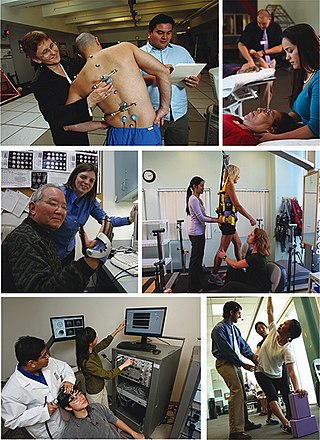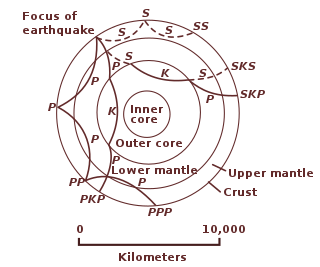Related Research Articles

Physical science is a branch of natural science that studies non-living systems, in contrast to life science. It in turn has many branches, each referred to as a "physical science", together is called the "physical sciences".

Anthropometry refers to the measurement of the human individual. An early tool of physical anthropology, it has been used for identification, for the purposes of understanding human physical variation, in paleoanthropology and in various attempts to correlate physical with racial and psychological traits. Anthropometry involves the systematic measurement of the physical properties of the human body, primarily dimensional descriptors of body size and shape. Since commonly used methods and approaches in analysing living standards were not helpful enough, the anthropometric history became very useful for historians in answering questions that interested them.

Gait analysis is the systematic study of animal locomotion, more specifically the study of human motion, using the eye and the brain of observers, augmented by instrumentation for measuring body movements, body mechanics, and the activity of the muscles. Gait analysis is used to assess and treat individuals with conditions affecting their ability to walk. It is also commonly used in sports biomechanics to help athletes run more efficiently and to identify posture-related or movement-related problems in people with injuries.

Kinesiology is the scientific study of human body movement. Kinesiology addresses physiological, anatomical, biomechanical, pathological, neuropsychological principles and mechanisms of movement. Applications of kinesiology to human health include biomechanics and orthopedics; strength and conditioning; sport psychology; motor control; skill acquisition and motor learning; methods of rehabilitation, such as physical and occupational therapy; and sport and exercise physiology. Studies of human and animal motion include measures from motion tracking systems, electrophysiology of muscle and brain activity, various methods for monitoring physiological function, and other behavioral and cognitive research techniques.
The anthropometry of the upper arm is a set of measurements of the shape of the upper arms.

The following outline is provided as an overview of and topical guide to Earth science:
The body fat percentage of an organism is the total mass of its fat divided by its total body mass, multiplied by 100; body fat includes essential body fat and storage body fat. Essential body fat is necessary to maintain life and reproductive functions. The percentage of essential body fat for women is greater than that for men, due to the demands of childbearing and other hormonal functions. Storage body fat consists of fat accumulation in adipose tissue, part of which protects internal organs in the chest and abdomen. A number of methods are available for determining body fat percentage, such as measurement with calipers or through the use of bioelectrical impedance analysis.
In physical fitness, body composition refers to quantifying the different components of a human body. The selection of compartments varies by model but may include fat, bone, water, and muscle. Two people of the same gender, height, and body weight may have completely different body types as a consequence of having different body compositions. This may be explained by a person having low or high body fat, dense muscles, or big bones.

Human body shape is a complex phenomenon with sophisticated detail and function. The general shape or figure of a person is defined mainly by the molding of skeletal structures, as well as the distribution of muscles and fat. Skeletal structure grows and changes only up to the point at which a human reaches adulthood and remains essentially the same for the rest of their life. Growth is usually completed between the ages of 13 and 18, at which time the epiphyseal plates of long bones close, allowing no further growth.
The branches of science, also referred to as sciences, scientificfields or scientific disciplines, are commonly divided into three major groups:
Sports biomechanics is the quantitative based study and analysis of athletes and sports activities in general. It can simply be described as the physics of sports. Within this specialized field of biomechanics, the laws of mechanics are applied in order to gain a greater understanding of athletic performance through mathematical modeling, computer simulation and measurement. Biomechanics, as a broader discipline, is the study of the structure and function of biological systems by means of the methods of mechanics.
Regulatory science is the scientific and technical foundations upon which regulations are based in various industries – particularly those involving health or safety. Regulatory bodies employing such principles in the United States include, for example, the FDA for food and medical products, the EPA for the environment, and the OSHA for work safety.
Somatotype is a theory proposed in the 1940s by the American psychologist William Herbert Sheldon to categorize the human physique according to the relative contribution of three fundamental elements which he termed somatotypes, classified by him as ectomorphic, mesomorphic, and endomorphic. He created these terms borrowing from the three germ layers of embryonic development: The endoderm, the mesoderm and the ectoderm. Later variations of these categories, developed by his original research assistant Barbara Heath, and later by Lindsay Carter and Rob Rempel, are used by academics today.
The following outline is provided as an overview of and topical guide to natural science:

The following outline is provided as an overview of and topical guide to geophysics:

Ergonomics, also known as human factors or human factors engineering (HFE), is the application of psychological and physiological principles to the engineering and design of products, processes, and systems. Primary goals of human factors engineering are to reduce human error, increase productivity and system availability, and enhance safety, health and comfort with a specific focus on the interaction between the human and equipment.
The history of anthropometry includes its use as an early tool of anthropology, use for identification, use for the purposes of understanding human physical variation in paleoanthropology and in various attempts to correlate physical with racial and psychological traits. At various points in history, certain anthropometrics have been cited by advocates of discrimination and eugenics often as a part of some social movement or through pseudoscientific claims.
The following index is provided as an overview of and topical guide to science: Links to articles and redirects to sections of articles which provide information on each topic are listed with a short description of the topic. When there is more than one article with information on a topic, the most relevant is usually listed, and it may be cross-linked to further information from the linked page or section.

3D body scanning is an application of various technologies such as structured-light 3D scanner, 3D depth sensing, stereoscopic vision and others for ergonomic and anthropometric investigation of the human form as a point-cloud. The technology and practice within research has found 3D body scanning measurement extraction methodologies to be comparable to traditional anthropometric measurement techniques.
References
- Carter JE, Heath BH. Somatotyping: development and applications. New York: Cambridge University Press; 1990.
- Betancourt H. The human body of the ballet dancer. An analysis of the contemporaneous dancer from Cuba. (Ph.D. Dissertation) Institute for Anthropological Research, National Autonomous University of Mexico. Mexico DF. 2009.
- Ross WD, Hebbelinck M, Van Gheluwe B, Lemmens ML. Kinanthropométrie et l’apprétiation de l’erreur de mesure. Kinanthropologie 1972; 4:23-4.
- Stewart A. Kinanthropometry and body composition: A natural home for threedimensional photonic scanning. Journal of Sport Science 2010; 28(5): 455–457.
- Emerald Insight
- Eston,R., & Reilly, T. Kinanthropometry and Exercise Physiology Laboratory Manual: Tests, procedures and data. Routledge. (2008)
- 978-0-415-43720-2 Kinanthropometry and Exercise Physiology [ permanent dead link ]